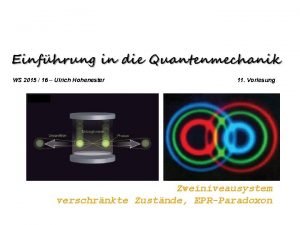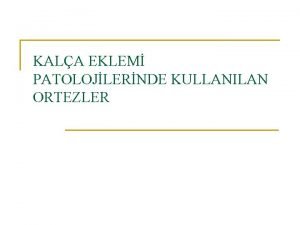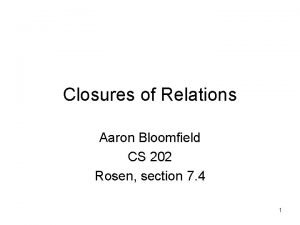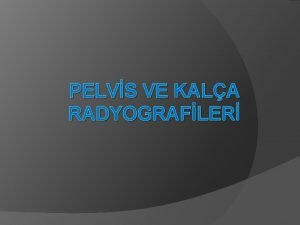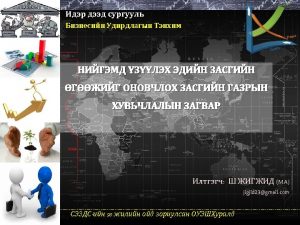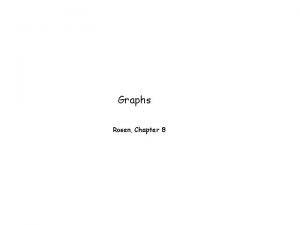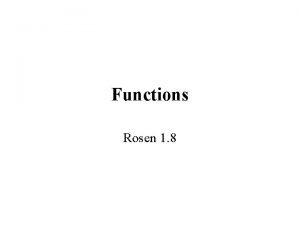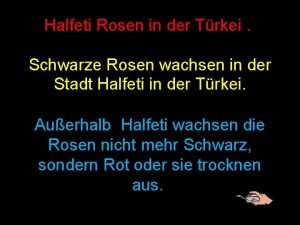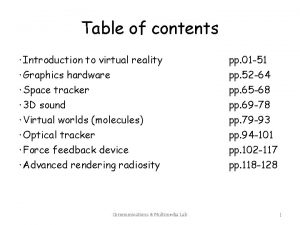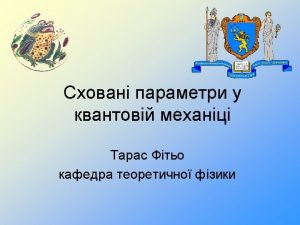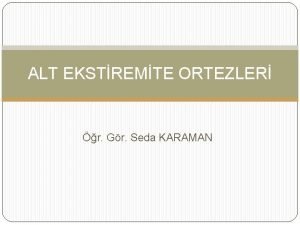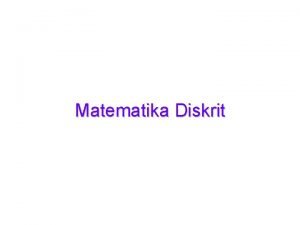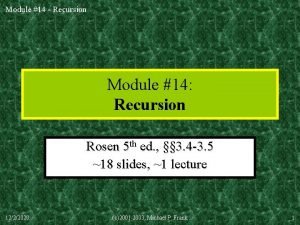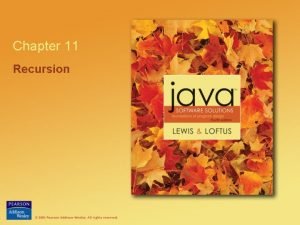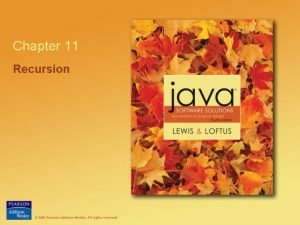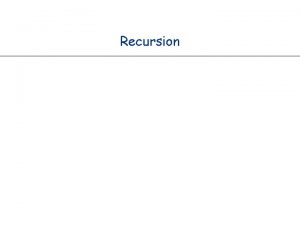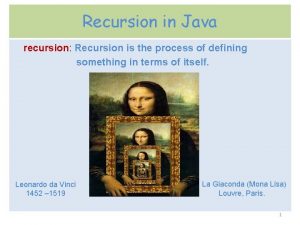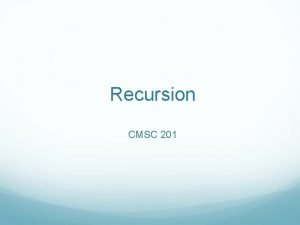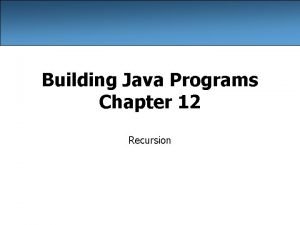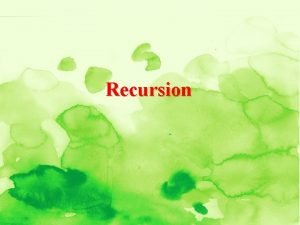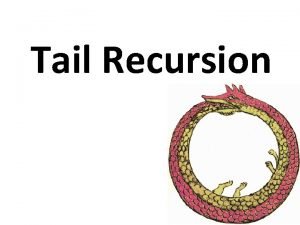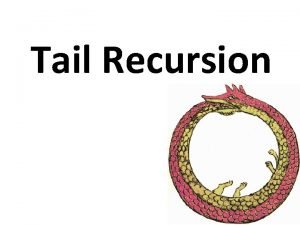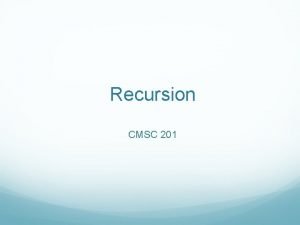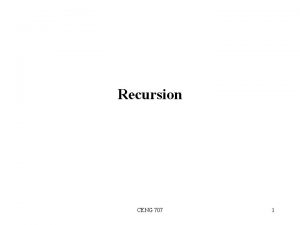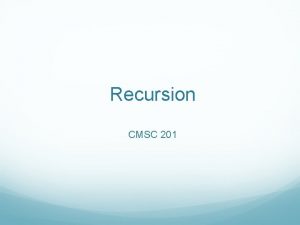Module 14 Recursion Module 14 Recursion Rosen 5





























![Module #14 - Recursion Recursive Quick Sort Void quicksort (int[] a, int lo, int Module #14 - Recursion Recursive Quick Sort Void quicksort (int[] a, int lo, int](https://slidetodoc.com/presentation_image/0799e654b3b75ecfb263b79b87f02ba2/image-30.jpg)
- Slides: 30

Module #14 - Recursion Module #14: Recursion Rosen 5 th ed. , §§ 3. 4 -3. 5 ~18 slides, ~1 lecture 2020/9/9 (c)2001 -2003, Michael P. Frank 1

Module #14 - Recursion § 3. 4: Recursive Definitions • In induction, we prove all members of an infinite set have some property P by proving the truth for larger members in terms of that of smaller members. • In recursive definitions, we similarly define a function, a predicate, or a set over an infinite number of elements by defining the function or predicate value or set-membership of larger elements in terms of that of smaller ones. 2020/9/9 (c)2001 -2003, Michael P. Frank 2

Module #14 - Recursion • Recursion is a general term for the practice of defining an object in terms of itself (or of part of itself). • An inductive proof establishes the truth of P(n+1) recursively in terms of P(n). • There also recursive algorithms, definitions, functions, sequences, and sets. 2020/9/9 (c)2001 -2003, Michael P. Frank 3

Module #14 - Recursion Recursively Defined Functions • Simplest case: One way to define a function f: N S (for any set S) or series an=f(n) is to: – Define f(0). – For n>0, define f(n) in terms of f(0), …, f(n− 1). • E. g. : Define the series an : ≡ 2 n recursively: – Let a 0 : ≡ 1. – For n>0, let an : ≡ 2 an-1. 2020/9/9 (c)2001 -2003, Michael P. Frank 4

Module #14 - Recursion Another Example • Suppose we define f(n) for all n N recursively by: – Let f(0)=3 – For all n N, let f(n+1)=2 f(n)+3 • What are the values of the following? – f(1)= 9 2020/9/9 f(2)= 21 f(3)= 45 f(4)= 93 (c)2001 -2003, Michael P. Frank 5

Module #14 - Recursion Recursive definition of Factorial • Give an inductive definition of the factorial function F(n) : ≡ n! : ≡ 2 3 … n. – Base case: F(0) : ≡ 1 – Recursive part: F(n) : ≡ n F(n-1). • • • 2020/9/9 F(1)=1 F(2)=2 F(3)=6 (c)2001 -2003, Michael P. Frank 6

Module #14 - Recursion Def 1: The Fibonacci Series • The Fibonacci series fn≥ 0 is a famous series defined by: f 0 : ≡ 0, f 1 : ≡ 1, fn≥ 2 : ≡ fn− 1 + fn− 2 0 1 1 2 3 58 13 2020/9/9 Leonardo Fibonacci 1170 -1250 (c)2001 -2003, Michael P. Frank 7

Module #14 - Recursion Inductive Proof about Fib. series Implicitly for all n N • Theorem: fn < 2 n. • Proof: By induction. Note use of 0 Base cases: f 0 = 0 < 2 = 1 base cases of f 1 = 1 < 21 = 2 recursive def’n. Inductive step: Use 2 nd principle of induction (strong induction). Assume k<n, fk < 2 k. Then fn = fn− 1 + fn− 2 is < 2 n− 1 + 2 n− 2 < 2 n− 1 + 2 n− 1 = 2 n. ■ 2020/9/9 (c)2001 -2003, Michael P. Frank 8

Module #14 - Recursion Inductive Proof about Fib. series • Theorem: whenever n 3, fn > an-2, where • Proof: • Basic step: a<2= f 3, a 2= = f 4 • Inductive step : Assume fj > aj-2 is true with , where. • Since a 2= a+1, ak-1= a 2.ak-3=(a+1) ak-3= ak-2+ ak-3 • fk+1= fk+ fk-1> ak-2+ ak-3= ak-1 2020/9/9 (c)2001 -2003, Michael P. Frank 9

Module #14 - Recursion LAME’S THEOREM • Let a and b be positive integers with. Then the number of divisions used by Euclidean algorithm to find gcd(a, b) is less than or equal to 5 times the number of decimal digits in b. Proof: 2020/9/9 (c)2001 -2003, Michael P. Frank 10

Module #14 - Recursion LAME’S THEOREM Assume there are n divisions to find gcd(a, b): r 0=r 1 q 1+r 2 0≦r 2<r 1 r 1=r 2 q 2+r 3 0≦r 3<r 2 … rn-2=rn-1 qn-1+rn 0≦rn<rn-1=rnqn. Note that q 1, q 2, … , qn-1≧ 1 and qn≧ 2. (Why? ) This implies that rn≧ 1=f 2, rn-1 ≧ 2 rn ≧ 2 f 2=f 3, rn-2 ≧rn-1+ rn ≧f 3 + f 2=f 4, … r 2 ≧r 3+ r 4 ≧fn-1 + fn-2=fn, b=r 1 ≧r 2+ r 3 ≧fn + fn-1=fn+1. 2020/9/9 (c)2001 -2003, Michael P. Frank 11

Module #14 - Recursion LAME’S THEOREM From Fibonacci series. We have fn+1 > an-1 for n>2. ( It follows that b > an-1. Since Hence Suppose b has k decimal digits. Then This finishes the proof. 2020/9/9 (c)2001 -2003, Michael P. Frank ) , . 12

Module #14 - Recursion Recursively Defined Sets • An infinite set S may be defined recursively, by giving: – A small finite set of base elements of S. – A rule for constructing new elements of S from previously-established elements. – Implicitly, S has no other elements but these. • Example: Let 3 S, and let x+y S if x, y S. What is S? 2020/9/9 (c)2001 -2003, Michael P. Frank 13

Module #14 - Recursion Def 2: The Set of All Strings • Given an alphabet Σ, the set Σ* of all strings over Σ can be recursively defined as: ε Σ* (ε : ≡ “”, the empty string) Book uses λ w Σ* x Σ → wx Σ* • Exercise: Prove that this definition is equivalent to our old one: 2020/9/9 (c)2001 -2003, Michael P. Frank 14

Module #14 - Recursion Def 3: String Concatenation • Let Σ be a set of symbols and Σ* the set of strings over Σ, the concatenation of two strings can be recursively defined as: Basic step: if w Σ*, then w. ε = w, ε is the empty string Recursive step: if w 1 Σ* w 2 Σ* x Σ, then w 1. (w 2 x) = (w 1. w 2 )x 2020/9/9 (c)2001 -2003, Michael P. Frank 15

Module #14 - Recursion Def 4: Rooted Trees • Basis Step: A single vertex is a rooted tree. • Recursive Step: Then the graph formed by starting with a root and adding an edge from r to each of r 1, r 2, …, rn, is also a rooted tree. Where T 1, T 2, …, Tn are rooted trees with roots r 1, r 2, …, rn respectively. 2020/9/9 (c)2001 -2003, Michael P. Frank 16

Module #14 - Recursion Def 5: Extended Binary Trees • Basis Step: f is an extended binary tree. • Recursive Step: If T 1 and T 2 are extended binary trees, there is an extended binary tree denoted by , consisting of a root r together with edges connecting the root to each of the roots of the left subtree T 1 and the right subtree T 2 when these trees are nonempty. 2020/9/9 (c)2001 -2003, Michael P. Frank 17

Module #14 - Recursion Def 6: Full Binary Trees • Basis Step: A single vertex r is a full binary tree. • Recursive Step: If T 1 and T 2 are full binary trees, there is a full binary tree denoted by , consisting of a root r together with edges connecting the root to each of the roots of the left subtree T 1 and the right subtree T 2. 2020/9/9 (c)2001 -2003, Michael P. Frank 18

Module #14 - Recursion Def 7: Height of Full Binary Tree • Basis Step: The height of the full binary tree T consisting of only a root r is h(T)=0. • Recursive Step: If T 1 and T 2 are full binary trees, then the full binary tree T= has height h(T)=1+max(h(T 1), h(T 2)). 2020/9/9 (c)2001 -2003, Michael P. Frank 19

Module #14 - Recursion Recursive Algorithms (§ 3. 5) • Recursive definitions can be used to describe algorithms as well as functions and sets. • Example: A procedure to compute an. procedure power(a≠ 0: real, n N) if n = 0 then return 1 else return a · power(a, n− 1) 2020/9/9 (c)2001 -2003, Michael P. Frank 20

Module #14 - Recursion Efficiency of Recursive Algorithms • The time complexity of a recursive algorithm may depend critically on the number of recursive calls it makes. • Example: Modular exponentiation to a power n can take log(n) time if done right, but linear time if done slightly differently. – Task: Compute bn mod m, where m≥ 2, n≥ 0, and 1≤b<m. 2020/9/9 (c)2001 -2003, Michael P. Frank 21

Module #14 - Recursion Modular Exponentiation Alg. #1 Uses the fact that bn = b·bn− 1 and that x·y mod m = x·(y mod m) mod m. (Prove the latter theorem at home. ) procedure mpower(b≥ 1, n≥ 0, m>b N) {Returns bn mod m. } if n=0 then return 1 else return (b·mpower(b, n− 1, m)) mod m Note this algorithm takes Θ(n) steps! 2020/9/9 (c)2001 -2003, Michael P. Frank 22

Module #14 - Recursion Modular Exponentiation Alg. #2 • Uses the fact that b 2 k = bk· 2 = (bk)2. procedure mpower(b, n, m) {same signature} if n=0 then return 1 else if 2|n then return mpower(b, n/2, m)2 mod m else return (mpower(b, n− 1, m)·b) mod m What is its time complexity? Θ(log n) steps 2020/9/9 (c)2001 -2003, Michael P. Frank 23

Module #14 - Recursion A Slight Variation Nearly identical but takes Θ(n) time instead! procedure mpower(b, n, m) {same signature} if n=0 then return 1 else if 2|n then return (mpower(b, n/2, m)· mpower(b, n/2, m)) mod m else return (mpower(b, n− 1, m)·b) mod m The number of recursive calls made is critical. 2020/9/9 (c)2001 -2003, Michael P. Frank 24

Module #14 - Recursion Recursive Euclid’s Algorithm procedure gcd(a, b N) if a = 0 then return b else return gcd(b mod a, a) • Note recursive algorithms are often simpler to code than iterative ones… • However, they can consume more stack space, if your compiler is not smart enough. 2020/9/9 (c)2001 -2003, Michael P. Frank 25

Module #14 - Recursion More Recursive Algorithms • Recursive Linear Search • Recursive Binary Search 2020/9/9 (c)2001 -2003, Michael P. Frank 26

Module #14 - Recursion and Iteration • Recursive Factorial vs. Iterative Factorial • Recursive Fibonacci vs. Iterative Fibonacci 2020/9/9 (c)2001 -2003, Michael P. Frank 27

Module #14 - Recursion Merge Sort procedure sort(L = 1, …, n) if n>1 then m : = n/2 {this is rough ½-way point} L : = merge(sort( 1, …, m), sort( m+1, …, n)) return L • The merge takes Θ(n) steps, and merge-sort takes Θ(n log n). 2020/9/9 (c)2001 -2003, Michael P. Frank 28

Module #14 - Recursion Merge Routine procedure merge(A, B: sorted lists) L = empty list i: =0, j: =0, k: =0 while ((i<|A|) (j<|B|)) {|A| is length of A} if i=|A| then Lk : = Bj; j : = j + 1 else if j=|B| then Lk : = Ai; i : = i + 1 else if Ai < Bj then Lk : = Ai; i : = i + 1 else Lk : = Bj; j : = j + 1 k : = k+1 return L Takes Θ(|A|+|B|) time 2020/9/9 (c)2001 -2003, Michael P. Frank 29
![Module 14 Recursion Recursive Quick Sort Void quicksort int a int lo int Module #14 - Recursion Recursive Quick Sort Void quicksort (int[] a, int lo, int](https://slidetodoc.com/presentation_image/0799e654b3b75ecfb263b79b87f02ba2/image-30.jpg)
Module #14 - Recursion Recursive Quick Sort Void quicksort (int[] a, int lo, int hi) { // lo is the lower index, hi is the upper index int i=lo, j=hi, h; int x=a[(lo+hi)/2]; do { // Partition while (a[i]<x) i++; while (a[j]>x) j--; if (i<=j) { h=a[i]; a[i]=a[j]; a[j]=h; i++; j--; } } while (i<=j); if (lo<j) quicksort(a, lo, j); // recursion if (i<hi) quicksort(a, i, hi); // recursion } 2020/9/9 (c)2001 -2003, Michael P. Frank 30
 Rosen die ich an dich verschenke
Rosen die ich an dich verschenke Eddie rosen brian rosen
Eddie rosen brian rosen To understand recursion you must understand recursion
To understand recursion you must understand recursion C device module module 1
C device module module 1 Michael rosen recount
Michael rosen recount Einstein-podolsky-rosen-paradoxon
Einstein-podolsky-rosen-paradoxon Toronto ortezi
Toronto ortezi Hip x ray
Hip x ray Birgitta rosen logoped
Birgitta rosen logoped Aaron bloomfield
Aaron bloomfield Jacob rosen ucla
Jacob rosen ucla Dr carol rosen
Dr carol rosen Pelvis grafi
Pelvis grafi 10 rosen für dich
10 rosen für dich Vascular sign of narath
Vascular sign of narath Mussa and rosen 1978
Mussa and rosen 1978 Handshaking lemma in graph theory
Handshaking lemma in graph theory One one and onto function
One one and onto function Walter g. rosen
Walter g. rosen Burnham rosen group
Burnham rosen group Scienza delle finanze rosen
Scienza delle finanze rosen Klisic test
Klisic test Eaton-rosen phenomenon
Eaton-rosen phenomenon Einstein rosen bridge equation
Einstein rosen bridge equation Urfa schwarze rose
Urfa schwarze rose David rosen sega
David rosen sega Epr einstein podolsky rosen
Epr einstein podolsky rosen Sophie rosen
Sophie rosen Von rosen cihazı
Von rosen cihazı Kenneth rosen discrete mathematics pdf
Kenneth rosen discrete mathematics pdf Homogeneous transform
Homogeneous transform





